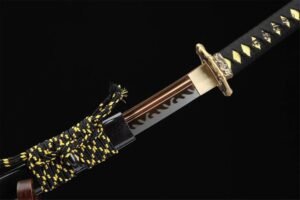Showing the single result
Exploring the Elegance and Power of the Naginata Sword
The Naginata sword, a symbol of both martial elegance and fierce power, has carved its way through history. This traditional Japanese weapon, renowned for its graceful yet deadly efficiency, has captivated enthusiasts and historians alike. In this blog, we will delve deep into the world of the Naginata sword, exploring its origins, design, and the role it played on the battlefield.
Unveiling the History of the Naginata Sword
The Naginata sword boasts a rich history dating back to as early as the 8th century. Originating in Japan, this weapon was not only a tool of war but also a symbol of social status and personal skill.
- Origins and Evolution: Initially used by the samurai class and sohei warrior monks, the Naginata evolved over centuries, adapting to the changing dynamics of warfare and martial arts practices.
- Cultural Significance: Beyond its martial application, the Naginata sword held a significant place in Japanese culture, symbolizing honor, bravery, and the spirit of the bushido code.
Design and Features of the Naginata Sword
The Naginata sword is distinguished by its unique design, blending functionality with artistry. This section will cover the key features that define the Naginata sword, making it a formidable weapon of its era.
Blade:
The blade of the Naginata sword is curved and slender, resembling that of a katana but much longer. This design allowed for both slicing and thrusting motions, making it versatile in combat.
Shaft:
The shaft, or nagaye, is another defining feature of the Naginata sword. Made from durable wood, it provided the wielder with extended reach, enabling them to engage enemies from a distance.
Usage:
The Naginata sword was predominantly wielded by foot soldiers against cavalry, as its length allowed for an effective defense and attack against mounted warriors.
The Role of the Naginata Sword in Battle
The Naginata sword was not only a weapon of individual combat but also played a significant role in the dynamics of Japanese warfare.
- Anti-Cavalry Weapon: Its design made it exceptionally effective against cavalry charges, disrupting the momentum of mounted troops.
- Women Warriors: Interestingly, the Naginata sword also became a symbol of empowerment for women, training in its use for self-defense and the protection of their homes in the absence of their samurai husbands.
Preserving the Legacy of the Naginata Sword
Today, the Naginata sword is celebrated not only as a historical artifact but also as a living tradition. Practitioners of Naginatajutsu, the martial art dedicated to mastering the Naginata sword, keep the spirit and techniques of this ancient weapon alive.
Modern Practice:
In modern times, Naginatajutsu has evolved into a competitive sport and a way to maintain physical fitness, discipline, and a connection to Japanese heritage.
Symbolic Meaning:
The Naginata sword continues to symbolize elegance, power, and the enduring legacy of Japan's martial traditions, inspiring both practitioners and historians worldwide.In summary, the Naginata sword's historical significance, unique design, and continued legacy offer a fascinating glimpse into Japan's martial culture. Whether on the battlefield of the past or in the dojos of today, the Naginata sword remains a powerful reminder of the skill, discipline, and spirit of the warriors who wielded it. Through ongoing practice and scholarly interest, the legacy of the Naginata sword endures, cementing its place in both history and contemporary martial arts.


